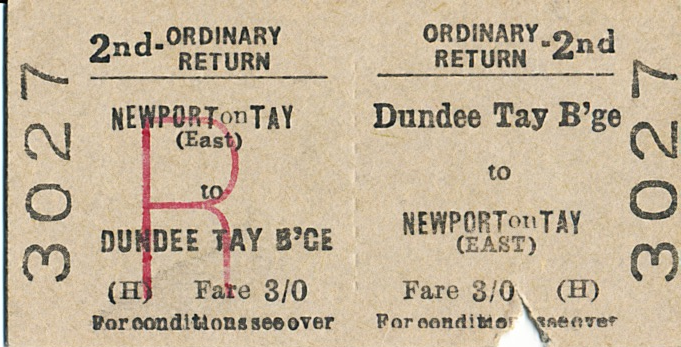Newport-on-Tay East Railway Station on:
[Wikipedia]
[Google]
[Amazon]
 Newport-on-Tay East railway station formerly served the town of
Newport-on-Tay East railway station formerly served the town of
remained practically unchanged till it closed. There were two accidents in the station. In one case, a train hit one of the level crossing gates, and it had to be replaced. The other accident was more serious. A workman was killed during an accident while shunting coal waggons.
 During the 1960s the trains were normally pulled by British Railways 2-6-4T engines. Later the steam trains were replaced by
During the 1960s the trains were normally pulled by British Railways 2-6-4T engines. Later the steam trains were replaced by
 Newport-on-Tay East railway station formerly served the town of
Newport-on-Tay East railway station formerly served the town of Newport-on-Tay
Newport-on-Tay is a small town in the north-east of Fife in Scotland, acting as a commuter suburb for Dundee. The Fife Coastal Path passes through Newport-on-Tay. The area itself is surrounded by views of the two bridges that cross the River Tay ...
, Fife, Scotland
Scotland (, ) is a Countries of the United Kingdom, country that is part of the United Kingdom. Covering the northern third of the island of Great Britain, mainland Scotland has a Anglo-Scottish border, border with England to the southeast ...
. The station closed in 1969.
Tayport branch
Newport-on-Tay East station was opened by North British Railway on 13 May 1879 with a branch line from the southern end of theTay Bridge
The Tay Bridge ( gd, Drochaid-rèile na Tatha) carries the railway across the Firth of Tay in Scotland between Dundee and the suburb of Wormit in Fife. Its span is . It is the second bridge to occupy the site.
Plans for a bridge over the Tay ...
which was later extended to Tayport. In 1923 it became the LNER LNER may refer to:
* London and North Eastern Railway, a railway company in the United Kingdom from 1923 until 1947
* London North Eastern Railway, a train operating company in the United Kingdom since 2018
* Liquid neutral earthing resistor, a typ ...
and from 1948 the Scottish Region of British Railways. The line was single track but with passing places at Wormit
Wormit is a village on the south shore of the Firth of Tay in north-east Fife, Scotland. Its location at the southern end of the Tay Rail Bridge has led to it becoming a commuter suburb of Dundee. Together with Woodhaven and Newport-on-Tay, Wo ...
station and the second was at Newport-on-Tay East. The single platform Newport-on-Tay West railway station was much smaller.
Description
The East station had two platforms which were curved slightly to follow the line of the track. At the end nearest Station Road there was a level crossing and a pedestrian bridge. The main ticket office, and the stationmaster's house were situated on the up track (towards Tayport). On the down track, there was only a waiting room. The station was lit by gas lamps, which were activated by the station staff. The signal box was situated at the far end of the Eastbound platform, and the signalmen used to hand the pouches containing the tokens for the stretch of track to Tayport from a platform situated on the stair leading up to the signal box. The strip of land between the up track and Norwood Terrace contained allotments. The land on the other side of the main tracks was taken up by a goods yard. Two coal merchants had their premises here. There was also an additional spur of track leading to a ramp which was used for loading sugar beet. At harvest time, tractors loaded with beet would drive in and tip the contents of their trailers into railway waggons parked on this spur. The station layout shown on the 1914 Ordnance Survey maremained practically unchanged till it closed. There were two accidents in the station. In one case, a train hit one of the level crossing gates, and it had to be replaced. The other accident was more serious. A workman was killed during an accident while shunting coal waggons.
Opening of the Tay Road Bridge
The railway was mainly used by people who lived in Newport and worked in Dundee. Until the opening of theTay Road Bridge
The Tay Road Bridge ( gd, Drochaid-rathaid na Tatha) carries the A92 road across the Firth of Tay from Newport-on-Tay in Fife to Dundee in Scotland, just downstream of the Tay Rail Bridge. At around , it is one of the longest road bridges in E ...
in 1966 the Tay Ferry provided the only alternative means of getting there. The opening of the Road Bridge allowed direct bus services from Newport to Dundee, as well as easy access by car, thus directly leading to the closure of the line in 1969.
 During the 1960s the trains were normally pulled by British Railways 2-6-4T engines. Later the steam trains were replaced by
During the 1960s the trains were normally pulled by British Railways 2-6-4T engines. Later the steam trains were replaced by diesel multiple units
A diesel multiple unit or DMU is a multiple-unit train powered by on-board diesel engines. A DMU requires no separate locomotive, as the engines are incorporated into one or more of the carriages. Diesel-powered single-unit railcars are also ...
, probably British Rail Class 101
The British Rail Classes 101 and 102 diesel mechanical multiple units were built by Metro-Cammell at Washwood Heath in Birmingham, England from 1956 to 1959, following construction of a series of prototype units. These classes proved to be som ...
.
References
{{Reflist Disused railway stations in Fife Former North British Railway stations Railway stations in Great Britain opened in 1879 Railway stations in Great Britain closed in 1969 1879 establishments in Scotland 1969 disestablishments in Scotland Newport-on-Tay